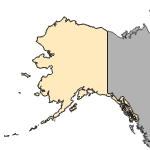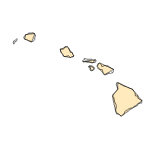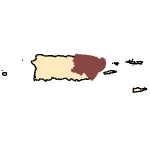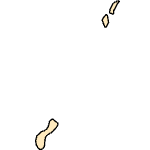Phenacogrammus interruptus
(Congo tetra)
Fishes
Exotic |
|
Common name: Congo tetra
Taxonomy: available through
www.itis.gov
Size: 8.0 cm male; 6.0 cm female (FishBase 2011).
Native Range: This species is native to the Middle Congo Basin in Africa (Froese and Pauly, 2012).



|

Alaska |

Hawaii |

Puerto Rico &
Virgin Islands |

Guam Saipan |
Hydrologic Unit Codes (HUCs) Explained
Interactive maps: Point Distribution Maps
Nonindigenous Occurrences:
Table 1. States with nonindigenous occurrences, the earliest and latest observations in each state, and the tally and names of HUCs with observations†. Names and dates are hyperlinked to their relevant specimen records. The list of references for all nonindigenous occurrences of Phenacogrammus interruptus are found here.
Table last updated 12/17/2025
† Populations may not be currently present.
Ecology: The Congo Tetra is benthopelagic and is found in waters with a pH between 6.0 and 8.0 (Froese and Pauly, 2012). The Congo Tetra feeds on worms, small insects, crustaceans, and plant matter. The female lays up to 300 eggs, which sink to the bottom and hatch in 6 days. The nest is not guarded (Mills and Vevers, 1989).
Males are larger and more colorful than females (SeriouslyFish, 2012a).
Means of Introduction: Aquarium release.
Status: Established in Puerto Rico.
Impact of Introduction: The impacts of this species are currently unknown, as no studies have been done to determine how it has affected ecosystems in the invaded range. The absence of data does not equate to lack of effects. It does, however, mean that research is required to evaluate effects before conclusions can be made.
References: (click for full references)
Erdman, D.S. 1984. Exotic fishes in Puerto Rico. Pages 162-176 in W. R. Courtenay, Jr. and J. R. Stauffer, Jr. (eds.), Distribution, Biology, and Management of Exotic Fishes. Johns Hopkins University Press, Baltmore, Maryland. 430 pp.
Froese, R. and D. Pauly (eds). 2012. FishBase. World Wide Web electronic publication. Available from: http://www.fishbase.org. Version (08/2012).
Mills, D. and G. Vevers. 1989. The Tetra encyclopedia of freshwater tropical aquarium fishes. Tetra Press, New Jersey. 208 p.
SeriouslyFish. 2012a. Phenacogrammus interruptus Congo Tetra. Available from: http://www.seriouslyfish.com/species/phenacogrammus-interruptus/ Accessed 3/26/2013.
Other Resources:
FishBase Summary
Author:
Fuller, P.
Revision Date: 8/6/2013
Peer Review Date: 8/6/2013
Citation Information:
Fuller, P., 2025, Phenacogrammus interruptus (Boulenger, 1899): U.S. Geological Survey, Nonindigenous Aquatic Species Database, Gainesville, FL, https://nas.er.usgs.gov/queries/FactSheet.aspx?speciesID=2632, Revision Date: 8/6/2013, Peer Review Date: 8/6/2013, Access Date: 12/17/2025
This information is preliminary or provisional and is subject to revision. It is being provided to meet the need for timely best science. The information has not received final approval by the U.S. Geological Survey (USGS) and is provided on the condition that neither the USGS nor the U.S. Government shall be held liable for any damages resulting from the authorized or unauthorized use of the information.